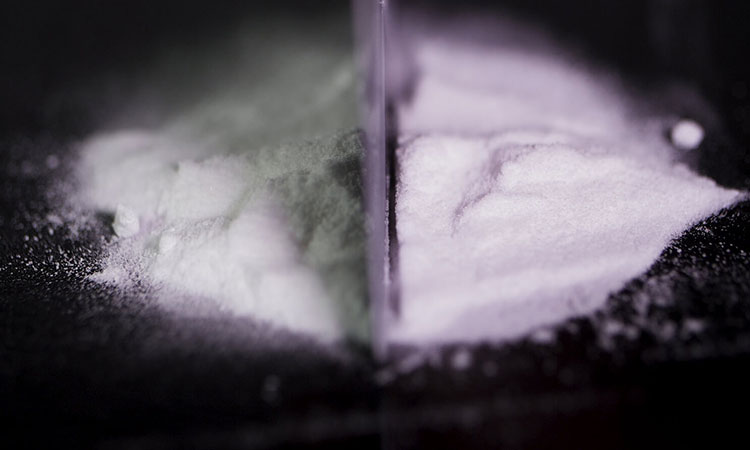
U-47700 (Pink) is a synthetic opioid “designer” drug about 7.5 times more potent than morphine.
In recent years, reports have surfaced of multiple deaths due to the use of U-47700. Its presence in the U.S. is believed to be primarily due to importation from labs in China. Pink has been found by law enforcement on the street in powder form and also as tablets. It usually appears as a white or light pinkish, chalky powder, sold in glassine bags stamped with logos mimicking heroin, in envelopes and inside knotted corners of plastic bags.
Even small doses of Pink can be toxic and potentially fatal. Labels on the products may issue statements such as “not for human consumption” or “for research purposes only” in an effort to circumvent legal detection. Deaths due to U-47700 in the U.S. join the increasing prevalence of drug overdose fatalities due to prescription and illicit opioids and other synthetic designer drugs.
U-47700 Effects and Toxicity
Pink is abused for its euphoric and pain-relieving effects, and can be swallowed, snorted or injected. Effects, as reported by users, are comparable to the effects of other opioids, which might include the following:
- Euphoria
- Sedation, relaxation, numbness
- Potent analgesia
- Severe and possibly fatal respiratory depression
- Pinpoint pupils
- Constipation
- Itching
- Drug tolerance, dependence, and addiction
- Tachycardia (increased heart rate)
- Seizures
- Psychosis
- Fatal overdose
U-47700 Use and Health Hazards
The Drug Enforcement Agency (DEA) reported there were at least 46 deaths associated with the use of U-47700 by December 2018. According to DEA, no cases of U-47700 use in the United States were reported before 2015.
Populations who use U-47700 are similar to those who use heroin, prescription painkillers, and other narcotics. Use of this substance may occur unknown to the person using as it may be found in conjunction with other drugs of abuse, such as heroin or fentanyl. Some illicit U-47700 products have been sold to imitate bags of heroin or prescription opioids.
These illegal substances originate from abroad, and the identity, purity, and potency of substances in any one product purchased on the street or the Internet may be unknown. A user may be told that the product contains one substance, while in reality, it could contain any number of other dangerous chemicals.
Those who abuse U-47700 are at risk for substance use disorders, overdose, and death, similar to the abuse of other narcotic drugs. For example, in Utah, two 13-year old boys died in September 2016 due to use of U-47700 purchased from the Internet.
U-47700 Overdose
Many users of U-47700 may become sedated to the point of respiratory arrest. If the overdose does not immediately prove lethal and someone is available to call for emergency help, first responders can administer naloxone, an opioid antidote, in an effort to save a life. However, there is the possibility that the effects of U-47700 may be so strong it could be resistant to naloxone, especially if multiple doses are unavailable.
Pharmacology of U-47700
U-47700 is a synthetic opioid agonist that acts on the mu-opioid receptor and was originally developed by scientists at Upjohn Pharmaceuticals in the 1970’s for the treatment of pain related to surgery, cancer, or injuries.
U-47700 has a similar chemical structure as morphine and other mu-opioid receptor agonists. According to the National Institute of Drug Abuse (NIDA), however, Pink is 7-8 times more potent than morphine.
Legal Status of U-47700 in the U.S.
On November 14, 2016, the Drug Enforcement Agency placed U-47700 into Schedule I of the Controlled Substances Act due to an immediate hazard to public safety and health. Substances in Schedule I are considered to have a high potential for abuse and no accepted medical use.
Temporary emergency scheduling of dangerous drugs is one tool the DEA uses to help regulate new and potentially deadly street drugs. Scheduling lasts at least 24 months, with a possible 12-month extension if the DEA needs additional time to decide if the chemical should remain as a Schedule I substance permanently.
Before the DEA’s scheduling, several states had already banned the drug under emergency orders, including Florida, Ohio, Wyoming, and Georgia.
Treatment For Opioid Addiction
Opioid addiction is a potentially deadly disease that directly affects the livelihood and health of those affected, as well as their loved ones. Individuals who suffer from opioid addiction are urged to seek long-term treatment on an inpatient or intensive outpatient basis.
Our center offers a comprehensive approach that features evidence-based services including psychotherapy, psychoeducation, individual and family counseling, and group support. We are staffed with caring medical and mental health professionals who specialize in substance abuse and employ these therapeutic modalities with compassion and expertise.
We provide clients with the education, tools, and support they need to achieve long-lasting abstinence. We can help you restore harmony and wellness to your life – contact us today to find out how!